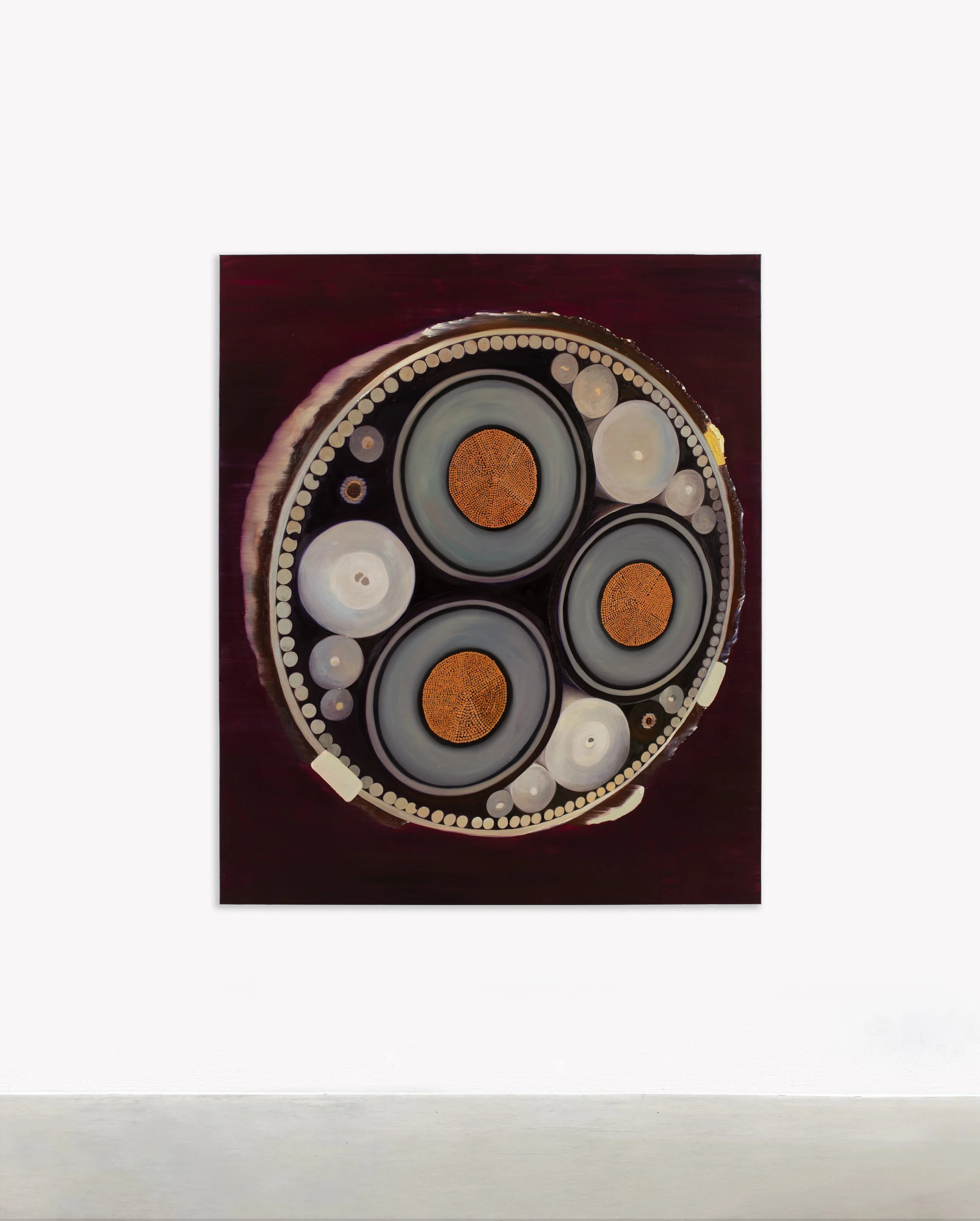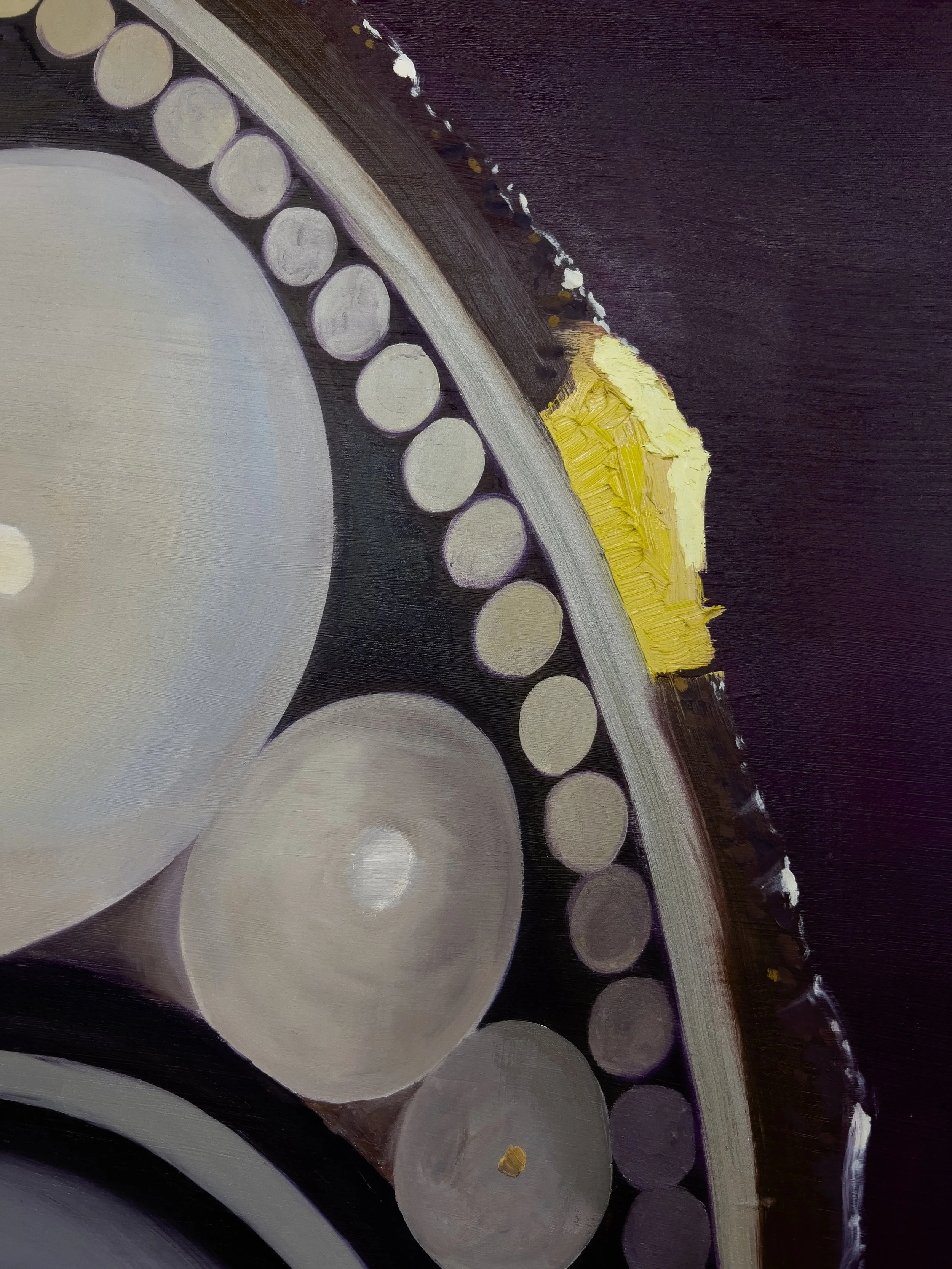Twenty Thousand Leagues Under the Seas, 2023
Twenty Thousand Leagues Under the Seas, 2023
Oil on linen
182 x 152 cm (72 x 60 in)
Amid the vast sea of innovation that defines contemporary culture, undersea cables exist beneath the surface as profound marvels of modern technology—evocative of the mysterious depths explored in Jules Verne’s Twenty Thousand Leagues Under the Sea. These concealed strands of fiber-optic brilliance traverse vast oceans, resonating through the currents of global communication. Seamlessly transmitting data across borders, they weave a network of international connectivity and access to the virtual world. Much like Captain Nemo’s Nautilus, these invisible pathways underpin e-commerce, financial systems, and remote labor, navigating the complex structures of real-time global dialogue. Within this submerged architecture, information flows and human collaboration form a symphony—quietly binding disparate systems to the global economy. Beyond their physical presence, submarine networks transcend infrastructure itself, symbolizing a boundless world of connection. Just as Verne's literary journey ventured into the unknown, these cables extend toward uncharted horizons of human connection, redefining the parameters of modern existence.
Q: What sparked your interest in undersea cables as an infrastructure?
Tan Mu: This line of inquiry began with my 2022 work Eruption, which depicted the dramatic eruption of the Hunga Tonga-Hunga Ha'apai volcano in Tonga and documented its impact on global communication networks. In January 2022, the eruption severely damaged Tonga's undersea cables, cutting off its communication with the world. It was the first time I realized how heavily contemporary society relies on submarine cables, even more so than on satellites, for its communication infrastructure. That realization sparked a deep curiosity in me.
When I created Twenty Thousand Leagues Under the Sea in 2023, I shifted my focus from a specific event to viewing submarine cables as symbols of global connectivity. Each structural layer of a fiber-optic cable serves a specific function and is carefully optimized for peak transmission performance. The internal structure features a multi-layered arrangement, including a fiber core, buffer layer, and reinforcement layer. A cross-sectional view reveals the precision of this man-made design, ensuring stable and efficient data transmission even in the extreme conditions of the deep sea. Through painting, I reimagine these technological marvels as metaphors that define the architecture of the modern world—structures that not only facilitate the flow of information but also embody the profound interconnections between culture, economy, and society.
Q: Is the materiality of undersea fiber-optic cables also a key aspect that draws you to create?
Tan Mu: Yes, part of my painting practice involves depicting materials and elements that constitute the hidden structures behind modern society. The plastic used in fiber-optic cables is one of the most significant synthetic materials of this century and plays a crucial role in today's world. The outer layer of the cable is made from high-strength plastic, which, as Michelle Guo puts it, is part of the "new order"—a symbol of emerging materials within the contemporary global context. As the technology and materials of undersea cables continue to evolve, my work documents these changes, transforming the artwork itself into a vessel of time.
Q: In your work, beyond being a technological infrastructure, how do undersea cables convey and reflect human cultural, social, and emotional connections?
Tan Mu: In my work, undersea cables are not merely technological infrastructures—they are mediums of human connection, embodying both tangible and intangible dimensions. They transmit flows of information, linking individuals, cultures, and societies across the globe. The cross-sectional structure of these cables resembles organic tissues, like cells and fibers. At first glance, it’s difficult to tell whether they are naturally grown or man-made. Much like a neural network, they serve as externalized channels of human memory, carrying personal information and recollections. These fiber-optic cables become pathways for memory transmission outside the body, forming an intimate relationship and interaction with the human form. As they intertwine and extend through the oceans, they connect our shared histories and collective consciousness. From this perspective, they are not just cables; they represent the invisible veins and backbone of a global human network. By depicting this global communication system, I attempt to visualize these hidden structures. It is not merely an abstract technological network, but a crystallization of labor, material, and intricate design.
Q: How do you express the "tangible and intangible, visible and invisible" characteristics of undersea cables in your creations?
Tan Mu: The relationship between the visible and invisible manifests on multiple levels in my work. First, undersea cables lie deep beneath the ocean floor—their massive scale and secrecy make them nearly impossible to document or photograph directly. As a result, painting becomes a form of indirect documentation, transforming these "invisible structures" into visible presences. Second, as conduits for information transmission, undersea cables carry the flow of collective human memory. This process of making the intangible tangible also mirrors the cultural, social, and emotional connections they facilitate. This invisibility also extends to the labor metaphor embedded within them. As a vast infrastructure, undersea cables are the result of immense human effort and material investment.
Q: Your ongoing new series Signal continues the discussion of submarine fiber-optic cables, extending from a focused cross-sectional structure to exploring the global network. Could you briefly talk about this series?
Tan Mu: After completing Twenty Thousand Leagues Under the Sea, I shifted my creative focus from a single geographical event to the information landscape of the entire global network. Through the depiction of cables and nodes, I seek to construct a panoramic view in which information flows and signal interruptions exist side by side. As an ongoing regional series, Signal not only reflects the labor, geopolitics, cultural histories, and technological distribution embedded in these networks, but also portrays each cable as a "signal line" interwoven with emotions and information, recording and transmitting collective human memories and feelings. By integrating star charts and "Classic of Mountains and Seas," I metaphorically present modern submarine cables as digital constellations and maps that navigate contemporary society, forming a chapter in my ongoing artistic exploration of hidden structures.





